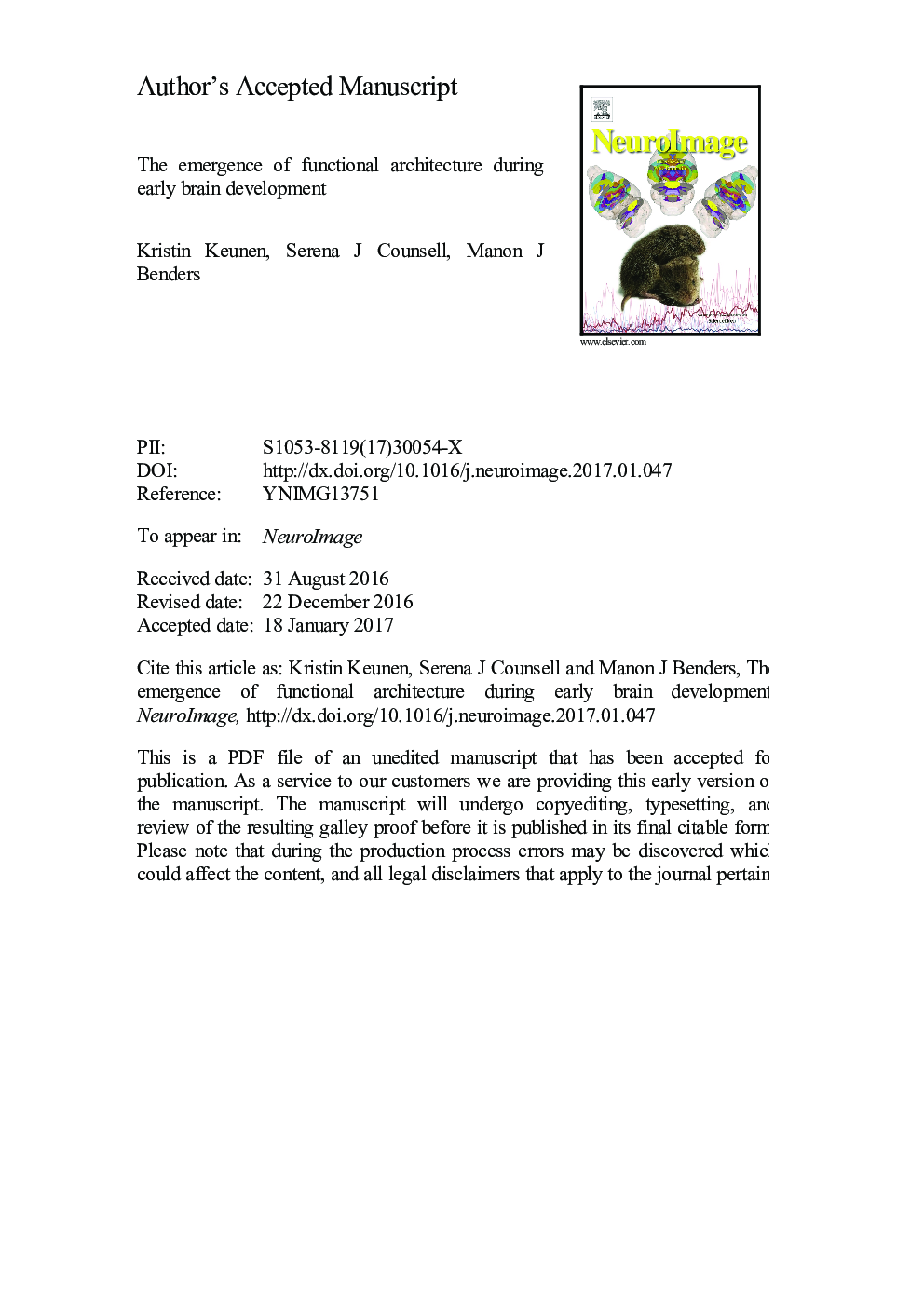| کد مقاله | کد نشریه | سال انتشار | مقاله انگلیسی | نسخه تمام متن |
|---|---|---|---|---|
| 8687477 | 1580850 | 2017 | 58 صفحه PDF | دانلود رایگان |
عنوان انگلیسی مقاله ISI
The emergence of functional architecture during early brain development
ترجمه فارسی عنوان
ظهور معماری کاربردی در طی رشد اولیه مغز
دانلود مقاله + سفارش ترجمه
دانلود مقاله ISI انگلیسی
رایگان برای ایرانیان
کلمات کلیدی
ترجمه چکیده
پیشرفت اولیه مغز انسان یک دنباله ای از فرآیندهای پیچیده ای است که در آن اتوژنیزم های مدارهای عصبی کارکردی عملکردی ایجاد می شود. مسیرهای رشد شبکه های اولیه شبکه مغزی برنامه ریزی ژنتیکی می شوند و می توانند با تأثیرات اپی ژنتیکی و محیطی تغییر کنند. چنین تغییراتی ممکن است اثرات عمیقی بر روی توسعه ی عصبی داشته باشد، که عمدتا در طول عمر ادامه می یابد. این بررسی بر روی دوره بحرانی توسعه مغز و جنین در دوران پس از تولد تمرکز دارد. در اینجا ما یافته های مربوط به مطالعات نوروفیزیک را با تمرکز خاصی بر تحقیقات عملکردی مغناطیسی که بازتولید شبکه های پیشرفته مغز را در هر دو وضعیت بهداشتی و خطرناک یا بیماری بررسی می کنیم، می پردازیم. اولا، ما یک مرور کلی از فرایندهای توسعه که از دوره جنینی از ابتدای تولد آغاز می شود، به منظور شکل گیری ساختار شبکه مغز متمرکز می شود. دوم، توسعه شبکه عمر مغزی در مغز به طور معمول در حال توسعه مورد بحث قرار خواهد گرفت. سوم، ما در مورد عوامل خطر زایمان قبل و بعد از زایمان، که ممکن است با خطوط سیم کشی مغزی کارکرد، از جمله موارد ابتلا به عفونت قبل از زایمان، بیماری های روانی مادران و زایمان زودرس، مواجه شود. به طور خلاصه، مطالعات نشان داده است که طرح سازمان مغز انسان بالغ در مغز نوزادان وجود دارد. ویژگی های برجسته معماری مغز انسان حتی در 24 هفته پس از تصورات در مغز جنین در حال توسعه دیده می شود. در طول توسعه مغز پس از تولد، الگوی سیم کشی مغز بیشتر مجسمه داده شده و مدولاسیون می شود تا فکس کامل مغز انسانی را تبدیل کند، با بهبود عملکرد شبکه مغز که دقیق تر از بلوغ شبکه ساختاری مغز است. پیشرفت در تکنیک های تصویربرداری عصبی، راه را برای درک جامع از مسیرهای بلوغ توسعه شبکه مغز و همچنین اینکه چگونه ناسازگاری های زودرس بر روی این مسیرها تاثیر می گذارد، راه اندازی کرده اند. چنین بینشی برای درک ما از عملکرد مغز انسان، برای شناسایی زودرس نوزادان خطرناک و همچنین برای استراتژی های محافظه کارانه جدید، اساسی است.
موضوعات مرتبط
علوم زیستی و بیوفناوری
علم عصب شناسی
علوم اعصاب شناختی
چکیده انگلیسی
Early human brain development constitutes a sequence of intricate processes resulting in the ontogeny of functionally operative neural circuits. Developmental trajectories of early brain network formation are genetically programmed and can be modified by epigenetic and environmental influences. Such alterations may exert profound effects on neurodevelopment, potentially persisting throughout the lifespan. This review focuses on the critical period of fetal and early postnatal brain development. Here we collate findings from neuroimaging studies, with a particular focus on functional MRI research that interrogated early brain network development in both health and high-risk or disease states. First, we will provide an overview of the developmental processes that take place from the embryonic period through early infancy in order to contextualize brain network formation. Second, functional brain network development in the typically developing brain will be discussed. Third, we will touch on prenatal and perinatal risk factors that may interfere with the trajectories of functional brain wiring, including prenatal substance exposure, maternal mental illness and preterm birth. Collectively, studies have revealed the blueprint of adult human brain organization to be present in the neonatal brain. Distinct attributes of human brain architecture have even been detected in the developing fetal brain from as early as 24 postconceptional weeks. During postnatal brain development, the brain's wiring pattern is further sculpted and modulated to become the full facsimile of the adult human brain, with functional brain network refinement being more rigorous than structural brain network maturation. Advances in neuroimaging techniques have paved the way towards a comprehensive understanding of the maturational pathways of brain network development and of how early developmental adversity may affect these trajectories. Such insights are fundamental for our understanding of human brain functioning, for early identification of infants at risk, as well as for future neuroprotective strategies.
ناشر
Database: Elsevier - ScienceDirect (ساینس دایرکت)
Journal: NeuroImage - Volume 160, 15 October 2017, Pages 2-14
Journal: NeuroImage - Volume 160, 15 October 2017, Pages 2-14
نویسندگان
Kristin Keunen, Serena J. Counsell, Manon J.N.L. Benders,
